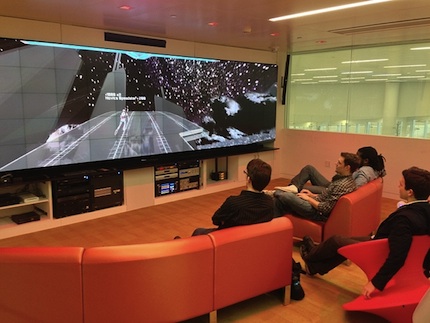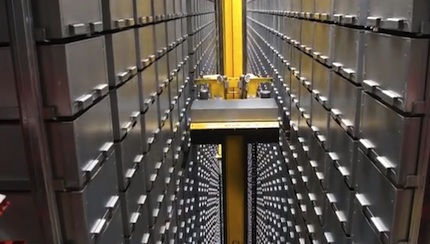NC State's Next-Gen Library Sounds Off About Audio in Collaborative Spaces
- By Dian Schaffhauser
- 06/17/13
North Carolina State University's new James B. Hunt Jr. Library has been showing off its "technology sandbox" operations, which include state-of-the-art audio-visual features intended to inspire visitors to go "wow!" The new 220,000 square-foot facility includes dedicated spaces for large-scale visualization, interactive displays, 3D motion technologies, and other visual elements. Those are equipped with audio components supplied by Sennheiser and K-array.
"We had to find the right technology partners that could fit into our vision," said Maurice York, head of information technology for the university's libraries. Noting that because the library was designed by Snøhetta, "one of the best architecture firms in the world," performance and form factor "were very important considerations for us all the way through. We wanted to create a sound environment that brought this incredible visual environment to life, so visitors would have that 'WOW' experience."
AV architects The Sextant Group handled AV design and supervised equipment specification. Installation was done by AVI-SPL, which specializes in video collaboration implementations.

Hunt Library Game Lab. (Click for larger image.) |
Sextant Systems Designer Scott Frey chose K-array's audio gear after visiting the company's demo room at the InfoComm conference in 2011. He said he thought the K-array system would fit the Library's Game Lab not just because of its sound quality but because of its small footprint.
"I had maybe 6 inches to work with for each speaker and had to ensure the sound was paramount," he recalled. "Two-inch linear drivers on the KK102 really sold me--a traditional loudspeaker would have been twice that size." He recommended K-array's equipment for other parts of the project too, along with headphones and wireless equipment from Sennheiser.
Sennheiser's education expert Eric Reese facilitated demonstrations of the hardware in rooms still under construction at the time, including what would eventually become the Auditorium. The libraries' York was part of those "auditions."
"Even though we knew the acoustical properties of the rooms would change, it was important for us to be inside the building and inside those spaces," he said. "After we set up [the] system in the Game Lab, we then went down to the Auditorium and auditioned several different types of music. The performance of the system just blew us away."
The team focused on multiple spaces, each requiring a different design and set-up.
The Immersion Theater serves as a presentation space for faculty to show off research and for students to discuss and review their projects. It features a 20-foot curved micro-tile display wall built with Christie MicroTiles (with a total of 492 used throughout the library) and a K-array sound system. According to York, "Part of the acoustic challenge was that the space was open to the main traffic throughway. We had to contain the sound inside of the space so it didn't bleed out into the reading rooms, but still provide an engaging audio experience." The AV people put up several K-array KV50 ultra-slim line arrays in the ceiling and KU36 ultra slim subwoofers above the video wall.

From left: 3D rendering of Hunt Library Game Lab, Teaching and Visualization Lab, and Creativity Studio. (Click for larger image.) |
The university's Game Lab doubles as a development lab and a place where students can play. The room features a 20-foot-wide micro display wall, which can be augmented into 80 separate LED displays, each measuring 10" x 12". Audio is delivered by a multi-channel system: three KK102s, positioned horizontally at left, right, and center of the wall; two KK52s serving as rear left and right channels; and a 12-inch KMT12P ultralight subwoofer, mounted under the display wall. The Game Lab also has Sennheiser wireless SR 300 IEM G3 transmitters, EK 300 IEM G3 receivers and RS 120 wireless headphones, as well as several Sennheiser lavaliere and handheld wireless microphones.
A Teaching and Visualization lab is designed as an open, "black box" theater that can be continually changed. The space has an open infrastructure overhead as well as exposed walls and flooring so that pipe grids, cables, electricity, and other infrastructure elements can be accessed. Surrounding the room is a 270-degree projection screen for an immersive wrap-around visual experience and audio that matches with the deployment used in the Game Lab.
The Creativity Studio follows a similar design as the Teaching and Visualization lab. This environment is designed for many people to use simultaneously with 16 sizable whiteboard panels that can be moved, reconfigured, or retracted; and large screens on both sides of the room and two rotating walls in the middle to divide the space as required. "Since the room could be divided into two rooms, we wanted each half of the room to have its own surround system," said York. These can be tied together to make a 10.2 system for the full room. The studio also uses an "intelligent" pipe clamping system to adjust the direction of speakers.
A 400-seat auditorium has a 30-foot wide screen — the largest on campus — complemented by a K-array surround sound system. Here, the speakers are hidden from view, mounted in niches behind the screen and behind acoustic paneling surrounding the space. The speaker set-up includes eight vertically mounted KK102s at the left, center, and right; four KK102s positioned at the rear left and right; as well as 16 KK52s around the perimeter of the room.
Added York, "We are seeing lots of potential applications for different types of speakers and ways we can use them in the different spaces, since they each have their own character."
Oh, and this library has books too — 1.5 million volumes, to be more specific. To make those available while still freeing up space for the collaborative uses, the library stores the volumes in a climate-controlled environment, sorted by size and barcoded. Then it does retrieval with bookBot, a custom robotic system that can deliver a book in about five minutes.

The Hunt Library bookBot stores a book. |